|
Humpty Dumpty sat on the wall,
Humpty Dumpty had a great fall,
All the king's horses and all the king's men,
Couldn't put Humpty Dumpty together again.
--Mother Goose
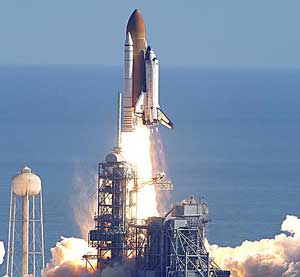 NASA’s human spaceflight workforce is hard at work attempting to get the space shuttle program back to flying status. But grasping at the Return to Flight (RTF) shuttle straw is proving elusive. NASA’s human spaceflight workforce is hard at work attempting to get the space shuttle program back to flying status. But grasping at the Return to Flight (RTF) shuttle straw is proving elusive.
Both inside and outside NASA, there are worries among the workforce that the more time the shuttle fleet sits grounded, other trouble spots may materialize. And if the RTF crusade stretches out month after month, and costs to counter those problems mount, the overall desire to fly the shuttle again could erode.
Last mission of the space shuttle program? Shuttle Columbia and its seven-person crew roars toward space on its fatal last flight. Crew and craft were lost on February 1, 2003. Mission STS-107 was the 28th flight of the orbiter Columbia and the 113th flight overall in NASA's space shuttle program since it started flying in 1981. Credit: NASA
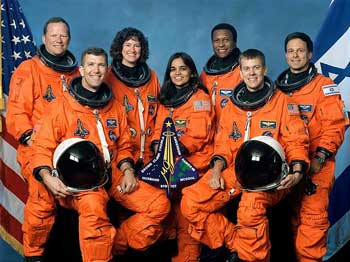 NASA astronauts are helping devise space walking procedures that might be called upon in repairing damaged thermal times if discovered on an Earth-circling shuttle. Credit: NASA NASA astronauts are helping devise space walking procedures that might be called upon in repairing damaged thermal times if discovered on an Earth-circling shuttle. Credit: NASA
International Space Station circles Earth, still far from being fully-assembled and capable of performing "world class" science duties. Credit: NASA
Being the "can do" agency it is, NASA is tackling a large "must do" list of technical issues to get a shuttle airborne.
NASA is also abiding by the White House space goals outlined by President George W. Bush in mid-January that include returning the shuttle to flight as soon as possible, but retire from service the space plane by 2010, the same year when the assembly of the International Space Station (ISS) is to be completed.
While all this is going on, the President also asked NASA to start fleshing out a human return to the Moon and planting humans on Mars over the next couple of decades.
If NASA is unable to return the shuttle to flight, will the public question how the same agency could ever be capable of transporting people back to the Moon, on to Mars and beyond?
On the other hand, with each return to flight shuttle delay, is canceling the program ibn order to save talent, time and taxpayer dollars becoming more appealing? Some argue that giving shuttle program personnel a stop work order now would allow scarce space funds to fortify NASA exploration beyond low Earth orbit.
Permanently grounding the shuttle, according to space experts contacted by SPACE.com, is sure to stir up a hornet’s nest of sticky issues.
Fear of flying
Now stuck in homeport are the remaining ships of the space fleet: Atlantis, Discovery, and Endeavour.
NASA remains steadfast in progressing toward a possible shuttle flight in March 2005. That goal, however, is likely to slip to later that year, according to aerospace industry observers.
Indeed, one early casualty in the balancing act NASA now finds itself is not sending astronauts on a repair mission to the Hubble Space Telescope.
"Not flying the Shuttle again would be an even harder decision to make than not flying it to Hubble," said John Logsdon, Director of the Space Policy Institute in the Elliott School of International Affairs at George Washington University, Washington, D.C. He was also a member of the Columbia Accident Investigation Board (CAIB).
"It is hard to think of how the International Space Station could be effectively used without the shuttle's capability to complete its assembly to a point where all partners agree it is adequate to their minimal aspirations," Logsdon said. "We may depend on other systems for operating ISS sooner than now planned, but losing the contributions that the shuttle can make would be close to tragic."
Logsdon pointed out that the CAIB did conclude that the shuttle could be operated safely for at least a few years, if proper care and attention were given. "If CAIB had intended to suggest that shuttle be grounded, our report would have said just that."
Should the nation cut its losses and immediately ground the shuttle? Doing so could help bankroll NASA’s new dream of going back to the Moon, setting up shop on Mars, and carrying out other bold missions.
"Not having the shuttle available to complete a more robust ISS would undermine the credibility of all that is planned to follow. Wanting to get a faster start on the new exploration initiative is not a good enough reason to retire the shuttle," Logsdon advised.
Gossip versus reality
Grounding the shuttle permanently is a painful option NASA understandably does not want to think about, said Matt Bille, a space historian specializing in launch systems in Colorado Springs, Colorado. "That doesn’t mean it’s out of the question," he said.
In taking a long-term view of how to move ahead with NASA’s vision for exploration, "all the options for structuring human spaceflight need to be considered," Bille said. "It depends a great deal on whether any additional problems that could delay return to flight are found in the shuttle fleet," he explained.
Immediate grounding of the shuttle is now more gossip than reality, said Roger Launius, Chair of the Division of Space History at the Smithsonian Institution’s National Air and Space Museum in Washington, D.C.
"I have been hearing the same rumors, and I think that at this point they are just that," Launius said. "But there seem to be some people in NASA that are concerned that the agency may be unable to meet all of the requirements placed on it by the CAIB…at least on a reasonable schedule and for a reasonable cost for return to flight," he added.
The dates for the next shuttle launch keep slipping, Launius noted, because of the difficulty of resolving the many concerns uncovered in the CAIB investigation and after their findings were issued.
"The more difficult the task of return to flight and the more the schedule slips -- as well as the very well-known issue of the overall aging of the fleet -- there will come a point when NASA officials will have to consider whether or not it is worth it to return the shuttle to flight," Launius said. "I'd be surprised if we are there just yet, but it is probably weighing on some people's minds."
Inventory of fixes
There is no doubt that the NASA-contractor community is at full-throttle diligently working toward the objective of winging shuttles back into space.
On the inventory of fixes: Prevent foam shedding off the shuttle’s external tank; search out plumbing leaks inside the remaining space planes; certify in-flight tile and wing edge inspection and repair procedures; and deal with braking mechanisms recently found to be improperly installed.
There are rumbles of other woes that are, quite literally, "waiting in the wings" -- like the control of corrosion in an aging shuttle’s superstructure brought about by the seaside salty clime of Kennedy Space Center in Florida.
"We will do everything in our power to return the shuttle safely to flight and to complete the assembly of the ISS," explained Brewster Shaw, Jr., Executive Vice President and Chief Operating Office of United Space Alliance (USA), the prime contractor for NASA's space shuttle program.
"We understand very clearly the consequences of failure in these first critical steps. Then, when requirements for their capability no longer exist, it is our goal to retire three perfectly viable space shuttle orbiters…as safe and reliable as they ever have been," Shaw explained at an April 1 panel at the 20th National Space Symposium held in Colorado Springs, Colorado.
Shaw said that, in order to complete the assembly of ISS, the space shuttle is needed. "That’s the only vehicle that exists that can deliver the elements to the station. So that’s a given if we’re going to continue assembly," he added.
Keeping critical skills
Work is also underway at the Lockheed Martin Space Systems Michoud Operations in New Orleans, Louisiana. They are the supplier of the shuttle’s huge external tank.
In an April 1 story by the Associated Press , it was reported that the firm cut 65 jobs due to President Bush’s decision to abandon the shuttle by decade’s end.
Marion LaNasa, Director of Communications at the plant, said work is progressing in preparing return-to-flight external tanks. While no new tanks are being built at present, he added that the firm is readying tooling and processes to restart full production.
"It’s very important to maintain the critical skills necessary to resume full-scale production work on external tanks," LaNasa said.
Two return-to-flight external tanks are already at the facility, LaNasa said. The company is awaiting approved post-Columbia design changes to the large piece of shuttle hardware, including a camera imagery system and improved spray-on and stay-on foam processes, he said.
"Any way we can improve the reliability of the tank we’re looking at…because we’ve got the time to do it," LaNasa said.
Climate control
Ostensibly to allow shuttle countdowns to start up again, now in place is a reactive whirlpool of task force overseers, safety boards, a leadership council, and layers of inspection and check point personnel. All this and more is part of an elaborate "Go/No-Go" labyrinth of decision-making.
In response to the agency-wide implications of the CAIB report, NASA last February awarded a contract to Behavioral Science Technology, Inc. (BST) of Ojai, California. According to a BST statement the work would "develop and administer a plan for safety climate and cultural change throughout the organization."
BST is to develop a three-tiered approach to improving agency culture and aligning it with the CAIB's recommendations. The change effort will be rolled out over a 36-month period with an initial goal of measurable progress within the next six months.
Earlier this week, BST reported the findings of a survey of NASA workers that assuredly is not morale-boosting news. The survey concluded that the agency "has not yet created a culture that is fully supportive of safety." Furthermore, BST survey findings indicated that workers remain uneasy about raising safety issues.
According to BST, NASA officials believe that successful implementation of the group’s culture change initiative contract will be critical to the agency's future as it prepares to return to flight and implement the President's vision for U.S. Space Exploration.
Cost limits
Getting the shuttle off-the-ground is not going to be cheap. And while moribund, not flying the shuttle also has cost implications for the still-in-construction space station.
NASA has one estimate on the streets regarding the price tag for returning the shuttle to flight: $600 million to $700 million.
An April 2 General Accounting Office (GAO) report to Congress, NASA: Compliance with Cost Limits, points out: Upon returning to flight, the shuttle will be dedicated to assembling the ISS and is to be retired upon completion of that work. "However, until the shuttle return to flight date is known, it will be difficult for NASA to provide reliable estimates of the increase in costs and the station’s completion date."
The GAO observes that grounding the U.S. shuttle fleet and uncertainties about the timing for returning the shuttle to flight will delay completion of the ISS and increase cost.
Factors in escalating cost, cited by GAO, involve the unplanned maintenance and storage of station components at Kennedy Space Center that were ready for launch; unplanned testing and recertification of some of the station’s components; and costs for extending contracts for the retention of critical skills longer than planned to complete development and assembly of the station.
Hangar queens and dumb decisions
Shortly after the Columbia accident, Harrison Schmitt, Apollo 17 moonwalker and former Senator from New Mexico, called for quickly fixing the primary cause of the accident and then go fly. There are too many national and international responsibilities to be unwilling to be an active space-faring nation, he argued.
Speaking recently to SPACE.com , Schmitt senses that the longer the shuttles stay grounded, the less likely it is that they will every fly. "Now, they seem to be finding more and more reasons to never fly. A rule with flying machines is that ‘hangar queens’ do not get better, only worse," Schmitt said.
There was unwillingness in the past, Schmitt said, to fund shuttle upgrades and enhancements that would have kept shuttles flying indefinitely. There was also the heritage of underfunding the shuttle's original development. Then there’s the legacy of not amortizing America’s investment in Apollo, he explained.
All of this adds up to a "tangled web of 35 years of dumb decisions," Schmitt concluded. "But we should suck it up and live with them and go fly, including to Hubble."
The devil we know
There is the prospect of making the shuttle space-worthy again, while dramatically reducing its launch rate.
Another avenue discussed in the past is taking an early "call it quits" space station strategy before fully-outfitting the Earth-circling complex. Labeled as "core complete", adopting this scheme would reduce the overall ability of the ISS to support research. Yet critics charge this approach calls into question whether the expensive and mega-outpost could ever live up to NASA’s early billing as a "world-class" research facility.
Thomas Jones, former shuttle astronaut, as well as a spacewalking ISS construction worker, foresees the space plane flying again in limited service. Its task is to finish the station out to, at least, U.S. core complete.
"The orbiter's capabilities to dock to ISS and use the manipulator system to deliver the large, remaining ISS components will be extremely difficult to replace," Jones noted. "Partner commitments make completion of the ISS a national priority, despite the long road back for the shuttle. In a sense, sticking with shuttle is understandable as a case of dealing with ‘the devil we know’", he said.
Jones said that, given the shuttle's fragility and the long wait to return, other options being bandied about by space experts deserve discussion.
Ground the shuttle now?
Capitol Hill lawmakers have begun hearing views about grounding the shuttle now.
Michael Griffin, former NASA Chief Engineer and the Associate Administrator for Exploration, recently scoped out a beyond-the-shuttle plan before the House of Representative’s Committee on Science.
"I, and others, have elsewhere advocated that the shuttle should be returned to flight and the ISS brought to completion, if only because the program’s two-decade advocacy by the United States and commitment to its international partners should not be cavalierly abandoned," Griffin testified. "But, if there is no additional money to be allocated to space exploration, this position becomes increasingly difficult to justify. It is worth asking whether our international partners might judge the issue similarly," he advised.
Griffin said that money saved by not returning shuttle to space would foot-the-bill, for example, on a small Crew Exploration Vehicle. This craft could be perched atop an augmented shuttle solid rocket motor for access to low Earth orbit. Funds would also be plowed into a shuttle-derived heavy lifter, sans a pilot-carrying orbiter.
Station on caretaker status
The space station would be put on caretaker status until Japan’s H-II Transfer Vehicle (HTV) and Europe’s Automated Transfer Vehicle (ATV) come on-line and are capable of hardware and supply delivery.
With all this in place, the reasoning goes, ISS could reach assembly complete sometime after 2010. Furthermore, key elements for pushing beyond low Earth orbit become available too -- all spurred by a diversion of shuttle funds.
"I admit it's far-fetched. Inertia favors the shuttle," former shuttle astronaut Jones said. "NASA is not currently so nimble as to be able to tackle such a huge challenge. And the ISS partners would not like to see their modules sitting on the ground until 2012. But they might be waiting nearly that long anyway."
Since Columbia, Jones said, he has thought that shuttle should retire when ISS assembly is done. "With its slow return, we have to ask how long it makes sense to stick with the shuttle when it's costing us other options."
Retire-the-shuttle decree
How serious is the White House edict to retire the shuttle in 2010 after 30 years of service?
First of all, it may take 30 shuttle flights to finish the station. The CAIB explained in their study that flying the shuttle more than five flights a year would be a challenge. Even if the shuttle is optimistically off-the-ground in March 2005, simple math adds up to not having space station construction wrapped until 2011-2012.
While the President’s space vision is definite on that 2010 retire-the-shuttle decree, safety of crew remains paramount and could well influence that date. Meanwhile, White House space policy makers have begun asking if there are any alternatives to finishing the ISS besides potentially flying the shuttle past 2010.
Notes space historian, Launius, whatever happens with shuttle, the question of America’s long-term assured access to space is a real concern. After more than four decades of spaceflight the problem is thornier than ever because of the shuttle's grounding, he said.
Human spaceflight support: broad but not deep
Left to be answered by the public and politicos are several key questions, suggested Launius: Is the United States as a nation willing to endure a period of several years when humans do not fly in space like it did between the time of the Apollo-Soyuz Test Project in 1975 and the first shuttle mission in 1981? Are we willing to end human spaceflight altogether?
"I think that the answer to both of these questions for most Americans is no," Launius responded. But while the support for human spaceflight is broad, he continued, it does not seem to be very deep.
"Americans like the shuttle and human spaceflight. They recognize the astronauts as heroes, but believe it is overly expensive -- when really it is not. So what do we do for the future? It seems uncertain at present," Launius said.
| Space
Shuttle Mission STS-107 -- Columbia |
| Crew
Members of STS-107 |
|
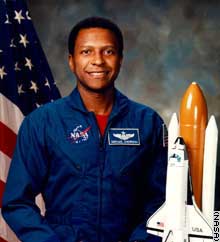 |
Michael
Anderson
ATLANTA, Georgia (CNN) -- Astronaut Michael
Anderson saw a "really bright" future
for African-American astronauts in space.
In his last interview,
Anderson, the only black crew member on space
shuttle Columbia, pointed out that three other
black astronauts were scheduled to be on shuttle
flights in the next year. |
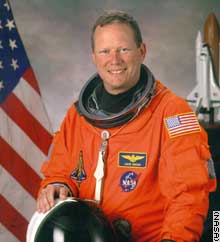 |
David
Brown
(CNN) -- A college gymnast and one-time circus
performer, David Brown said his experiences as an
acrobat, tumbler, stilt walker and 7-foot unicycle
rider helped him become a better astronaut.
"What I really learned from
that, and transfers directly to what I'm doing on
this crew, is kind of the teamwork and the safety
and the staying focused, even at the end of a long
day when you're tired and you're doing some things
that may have some risk to them," he told the
Associated Press. |
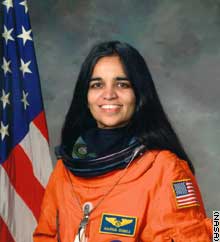 |
Kalpana
Chawla
| NEW DELHI, India --
The morning of the crash, front pages of Indian newspapers carried pictures of Kalpana Chawla, the first Indian-born woman in space, to celebrate her expected return to earth on the U.S.
Space Shuttle Columbia on a military deployment
mission.
In Chawla's hometown of Karnal,
75 miles northwest of the capital, New Delhi, a
gathering at her high school which had been
planned to celebrate the successful end of
Columbia's mission turned into a prayer vigil as
news of the accident was reported.
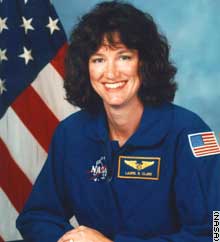 |
Laurel
Clark
It was her first trip into space,
but Astronaut Laurel Clark said she felt like an
experienced veteran after two weeks in orbit.
"This has been a great
experience for me," she said in a call from
space with a reporter from the Milwaukee Journal
Sentinel. "The first couple of days you don't
always feel too well. I feel wonderful now. The
first couple of days you adjust to the fluid
shifting, how to fly through space without hitting
things or anybody else. But then after a couple of
days you get in a groove. It's just an incredibly
magical place." |
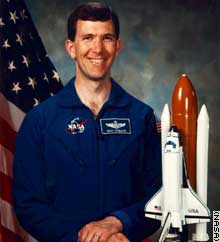 |
Shuttle
Commander Rick Husband
Rick Husband was a "true American hero"
who braved the risks of space flight in the name
of science, the president of his alma mater
university said.
A married father of two,
Husband, 45, was a colonel in the U.S. Air Force
who had already been to space once, aboard Space Shuttle
Discovery in 1999. But he was also an experienced
pilot who had logged more than 3,800 hours of
flight time in more than 40 types of aircraft,
including the F-15E Strike Eagle in 56 attack
missions during Desert Storm. |
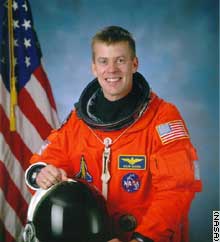 |
Willie
McCool
A Navy commander with more than 2,800 hours of flight experience,
Astronaut William "Willie" McCool nevertheless was spellbound by his first trip into space, calling it "beyond
my imagination."
In his last interview, given two nights before
liftoff, McCool, 41, said he was using an "Exercycle" both to stay in shape and run experiments.
"I'll tell you, there's nothing better than listening to a good
Pink Floyd album and looking out the windows and watching the world go by while you pedal on the
shuttle's space bike,"
said McCool. |
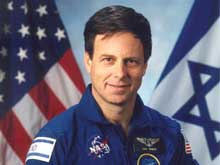 |
Ilan
Ramon
Israel's first astronaut,
shuttle Columbia Payload Specialist Ilan Ramon,
was praised as a symbol of "excellence and
freedom" and mourned by his countrymen as
"the best we could offer."
Colonel Ramon, 48, a career
military man, was the pilot who flew the lead F-15
strike fighter and dropped guided bombs on an
Iraqi nuclear plant that was under construction in
1981, destroying the main reactor and early Iraqi
nuclear weapon ambitions. |
| Mission
Systems:
Commercial
Payload:
Advanced Respiratory Monitoring System
Closed Equilibrated Biological Aquatic System
U.S. Air Force Technology Demonstration Experiment
Commercial and Macromolecular Protein Crystal
Growth
Combined Two-Phase-Loop Experiment
Quick External Science Tray
Space Technology and Research Students (STARS)
Program
Star Navigation
Osteoporosis Experiment in Orbit
European Research In Space and Terrestrial
Osteoporosis
Human Life Science Experiments
- Physiology
and Biochemistry Experiments Team (PhaAB-4)
- Enhanced
Orbiter Refrigeration Freezer (EOR/F)
- Thermoelectric
Holding Module (TEHM)
- Orbiter
Centrifuge
NASA/ESA
Barter Payload:
Biopack Experiment
Facility for Absorption and Surface Tension
Advanced Protein Crystallization Facility
Biobox Experiment
NASA
ISS RME Payload:
Vapor Compression Distillation Flight
Experiment
NASA
Code U Payload:
Combustion Module-2
Space Acceleration Measurement System - Free Flyer
Mechanics of Granular Materials
Bioreactor Development System-05
Ergometer Hardware
Human Life Science Experiments
- Microbial
Physiology Flight Experiments (MPFE)
- Automated
Microbial System (AMS)
- SLEEP-3
Astroculture
(Plant Growth Chamber)
Astroculture (Glovebox)
Commercial Protein Crystal Growth-PCF
Zeolite Crystal Growth-1
Fundamental Rodent Experiments Supporting
Health-Two
Gravisensing and Response System
Biological Research in Canisters
Commercial ITA Biomedical Experiments
USAF
Payload
MILSTAR II CENTCOM MK-IV Satellite Platform |
|